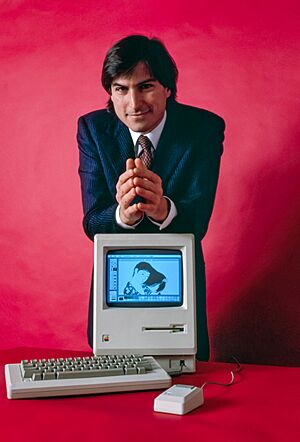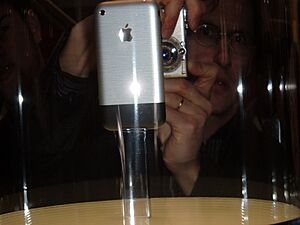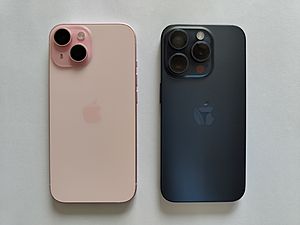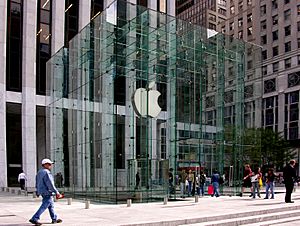Apple Inc. facts for kids

Apple logo used since 1998
|
|||

Aerial view of Apple Park, the company's headquarters, in Cupertino, California
|
|||
|
Formerly
|
|
||
|---|---|---|---|
| Public | |||
| Traded as | |||
| ISIN | [https://isin.toolforge.org/?language=en&isin=US0378331005 US0378331005] | ||
| Industry |
|
||
| Founded | April 1, 1976 , in Los Altos, California, U.S. | ||
| Founders | |||
| Headquarters | 1 Apple Park Way,
,
U.S.
|
||
|
Number of locations
|
535 Apple Stores (2025) | ||
|
Area served
|
Worldwide | ||
|
Key people
|
|||
| Products |
|
||
| Services |
|
||
| Revenue | |||
|
Operating income
|
|||
| Total assets | |||
| Total equity | |||
|
Number of employees
|
164,000 (FY24) | ||
| Subsidiaries |
|
||
|
|||
| Footnotes / references Financials as of September 28, 2024[update]. References: |
|||
Apple Inc. is a famous American technology company based in Cupertino, California. It is known all over the world for making popular electronics, computer software, and online services. Some of its most famous products include the iPhone, iPad, and Mac computers.
Apple was started in 1976 by Steve Jobs, Steve Wozniak, and Ronald Wayne. They first created the Apple I personal computer. The company grew quickly and became a leader in technology. In 2007, it changed its name from Apple Computer, Inc. to Apple Inc. to show it made more than just computers.
Today, Apple is one of the largest and most valuable companies in the world. It is famous for its innovative products and has a very loyal group of customers. The company is led by CEO Tim Cook, who took over after Steve Jobs passed away in 2011.
History of Apple
1976–1980: How Apple Got Started
Apple Computer Company was founded on April 1, 1976. The company's first product was the Apple I, a computer that was designed and built by hand by Steve Wozniak. To get money to build it, Steve Jobs sold his van and Wozniak sold his special calculator.
The Apple I was shown for the first time at a computer club in July 1976. It was sold as a circuit board, which meant users had to add their own keyboard and monitor. Soon after, the company was officially formed as Apple Computer, Inc. on January 3, 1977.
The Apple II computer, also designed by Wozniak, was introduced in 1977. It was a huge success because it had color graphics, which was rare at the time. It became one of the first mass-produced personal computers and helped Apple grow very quickly.
1980–1990: The Success of the Macintosh
In 1984, Apple launched the Macintosh. It was one of the first personal computers to have a graphical user interface (GUI) and a mouse. This made it much easier for people to use computers without needing to type complex commands.
The Macintosh was introduced with a famous TV commercial called "1984" that aired during the Super Bowl. The ad was a huge hit and made people very excited about the new computer.
However, disagreements inside the company led to Steve Jobs leaving Apple in 1985. After he left, the company continued to sell Macs. It became very popular for desktop publishing, which is using a computer to create documents for printing.
1990–1997: A Period of Challenges
In the 1990s, Apple faced tough competition from computers that used the Microsoft Windows operating system. These computers, often called PCs, were cheaper than Macs. As a result, Apple started to lose money and its place in the market.
The company tried to make many different products, but most were not successful. By 1997, Apple was very close to going out of business. To save the company, Apple bought NeXT, a company that Steve Jobs had started after he left. This brought Jobs back to Apple.
1997–2007: The Return of Steve Jobs
When Steve Jobs returned, he made big changes. He simplified the product line to focus on just a few key computers. In 1998, he introduced the iMac, a colorful all-in-one computer that was a huge success. The iMac helped bring Apple back to profitability.
This period was a time of great innovation for Apple. The company launched many new products that changed technology forever.
- The iPod (2001) was a portable music player that could hold thousands of songs.
- The iTunes Store (2003) let people buy and download music legally online.
- The iPhone (2007) was a revolutionary smartphone that combined a phone, an iPod, and an internet device into one.
In 2001, Apple also opened its first Apple Stores. These retail stores allowed customers to see and try out Apple products in a friendly environment. The stores became very popular and successful.
2007–2011: The Age of Mobile Devices
With the success of the iPhone, Apple became a major player in the mobile phone industry. The company also launched the App Store in 2008. This allowed people to download thousands of applications, or "apps," for their iPhones.
In 2010, Apple introduced the iPad, a tablet computer with a large touchscreen. The iPad created a new category of devices between a smartphone and a laptop. It was perfect for watching videos, reading books, and playing games.
During this time, Steve Jobs's health was declining. In August 2011, he stepped down as CEO and was replaced by Tim Cook. Steve Jobs passed away in October 2011, leaving behind a legacy of innovation.
2011–2020: The Tim Cook Era
Under Tim Cook's leadership, Apple continued to grow and release new products. The company launched the Apple Watch in 2014, a smartwatch that tracks fitness and shows notifications from an iPhone. Apple also introduced services like Apple Music, a music streaming service, and Apple Pay, a mobile payment system.
The iPhone continued to be Apple's most important product, with new models released every year. The company also updated its Mac and iPad lines with more powerful and thinner designs. In 2018, Apple became the first U.S. company to be valued at over $1 trillion.
2020–Present: New Technologies
In 2020, Apple began a major change for its Mac computers. It started using its own custom-designed processors, called Apple silicon, instead of chips from Intel. These new chips, like the M1, made Macs faster and more energy-efficient.
Apple also continued to expand into new areas. In 2023, it announced the Apple Vision Pro, a mixed-reality headset that blends digital content with the real world. In 2024, the company introduced Apple Intelligence, its own system for artificial intelligence (AI) features in its products.
In 2025, Apple announced a major investment of over $500 billion in the United States. This plan included building new facilities and creating jobs in technology and manufacturing.
Apple's Most Famous Products
Apple is known for creating products that are easy to use and have a clean, simple design.
Mac
The Mac is Apple's line of personal computers. It includes laptops like the MacBook Air and MacBook Pro, and desktop computers like the iMac and Mac Pro. Macs run on an operating system called macOS. They are popular with creative professionals, students, and many other users.
iPhone
The iPhone is Apple's line of smartphones. It runs on the iOS operating system and is known for its powerful camera, easy-to-use interface, and the millions of apps available on the App Store. The iPhone is Apple's best-selling product and generates a large part of the company's revenue.
iPad
The iPad is Apple's line of tablet computers. It is great for watching movies, drawing with the Apple Pencil, and getting work done on the go. There are different models, including the standard iPad, the smaller iPad Mini, and the more powerful iPad Air and iPad Pro.
Other Products
Apple also makes other popular devices:
- Apple Watch: A smartwatch that tracks health and fitness, shows notifications, and lets you make calls.
- AirPods: Wireless earbuds that connect easily to Apple devices.
- Apple TV: A device that lets you stream movies and TV shows on your television.
- HomePod: A smart speaker that plays music and works with Siri, Apple's voice assistant.
Corporate Information
Leadership
Apple is led by a team of executives. The most well-known leaders are:
- Tim Cook: The chief executive officer (CEO), who is in charge of the whole company.
- Jeff Williams: The chief operating officer (COO), who manages daily operations.
The company also has a board of directors that helps guide its major decisions. The chairman of the board is Arthur D. Levinson.
Offices and Stores
Apple's main headquarters is called Apple Park and is located in Cupertino, California. It is a huge, circular building that looks like a spaceship. It is known for being environmentally friendly and is surrounded by parkland.
Apple also has over 500 retail stores around the world. These stores are famous for their modern design and the Genius Bar, where customers can get help with their products.
Environmental Efforts
Apple has made a commitment to protecting the environment. The company aims to be carbon neutral for all its products by 2030. This means it is working to reduce its impact on climate change.
All of Apple's offices, data centers, and retail stores are powered by 100% renewable energy, like solar and wind power. The company also focuses on using recycled materials in its products and making them more energy-efficient.
See also
 In Spanish: Apple para niños
In Spanish: Apple para niños







